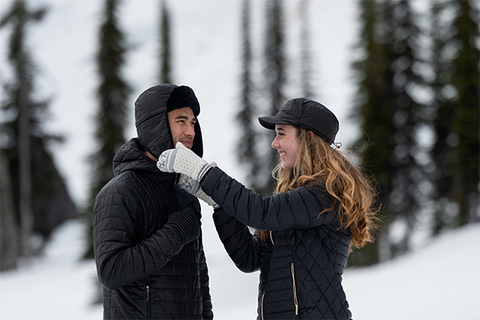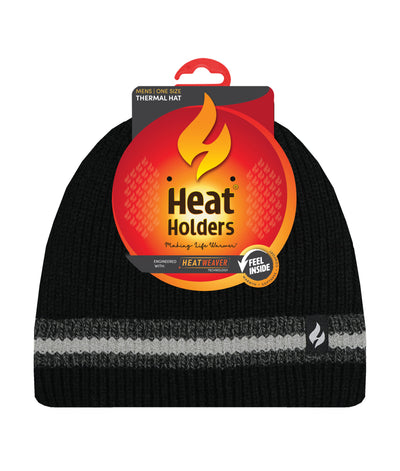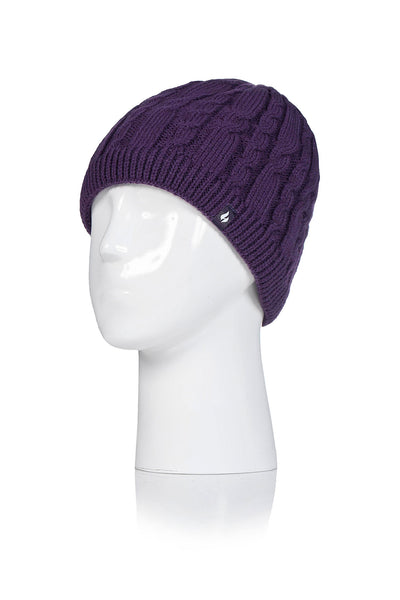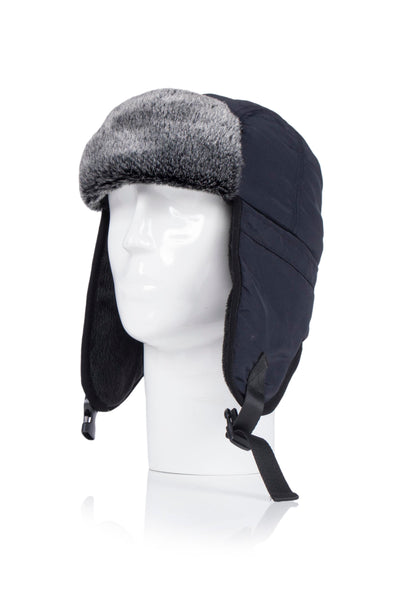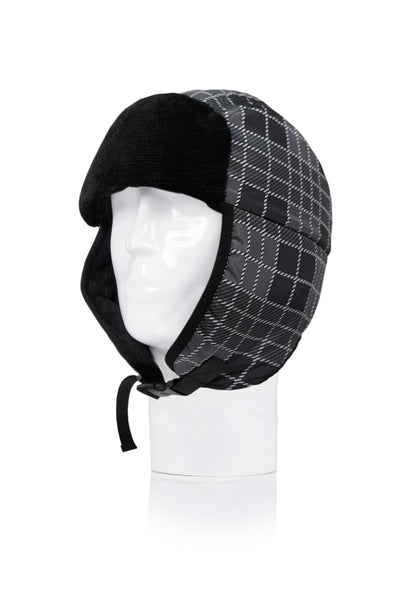When it comes to staying warm during the colder months, one of the most important accessories in your wardrobe is a hat. But with so many options to choose from, how do you know which type of hat will provide the most warmth?
In this article, we will:
- Understand the basics of a beanie and winter hat
- Discuss materials used, like wool or polyester
- Highlight the construction and design and how it contributes to warmth
- Discuss fit and comfort, and
- Settle the debate once and for all: beanie or winter hat - which is warmer?
Alt text: A person out for a winter hike
Understanding the Basics: Beanie and Winter Hat
What Is a Beanie?
A beanie is a type of hat that is typically made from knit fabric. It is characterized by its close-fitting design, covering the head and sometimes the ears. Beanies are often made from materials such as wool, acrylic, or cotton, providing both warmth and breathability.
Beanies have been a popular choice for both men and women, especially during the colder months. They are versatile and can be styled in various ways to suit different outfits and personal preferences. Some beanies feature a folded brim, adding a touch of style and extra warmth to the design. Others may have a pom-pom on top, giving them a playful and fun look.
One of the advantages of wearing a beanie is its ability to keep the head and ears warm without sacrificing comfort. The knit fabric allows for some stretch, ensuring a snug fit that stays in place even during outdoor activities. Additionally, beanies are lightweight and easy to pack, making them a convenient accessory to carry around.
What Is a Winter Hat?
A winter hat, also known as a trapper hat or earflap hat, is designed to provide maximum warmth and protection against cold temperatures. Unlike a beanie, winter hats often have a brim and ear flaps that can be secured under the chin to cover the entire head and protect the ears from the elements. Winter hats are commonly made from materials like fleece, faux fur, or waterproof fabrics.
Winter hats are a popular choice for those living in regions with harsh winters or engaging in outdoor winter activities. The brim of a winter hat helps shield the face from snow, rain, and wind, providing added protection against the elements. The ear flaps can be folded down to cover the ears, ensuring they stay warm and cozy even in freezing temperatures.
Trapper hats, a specific type of winter hat, often feature a fur lining or trim, which adds an extra layer of insulation and a touch of luxury. IHeat Holders® winter hats are made with our HeatWeaver® lining, a super soft thermal lining that traps warm air next to your head, keeping you warmer for longer. These hats have a timeless appeal and are commonly associated with outdoor adventures, such as skiing or hiking in snowy mountains.
Some winter hats also come with built-in earphones or Bluetooth connectivity, allowing wearers to listen to music or make calls while keeping their head warm.
Material Matters: What Makes a Hat Warm?
When it comes to keeping our heads warm during the cold winter months, choosing the right material for our hats is essential. Not all hats are created equal in terms of warmth and insulation. Let's take a closer look at the common materials used in beanies and winter hats and what makes them effective in combating the chill.
Common Materials in Beanies
Beanies, with their snug fit and versatile style, have become a staple in winter fashion. They can be made from various materials, each offering its own level of warmth and insulation.
Wool beanies are a popular choice due to their natural heat-trapping properties. Wool fibers have tiny air pockets that help retain body heat, making them incredibly effective at keeping our heads warm. Additionally, wool has the ability to wick away moisture, ensuring that our heads stay dry even during intense physical activities in the cold.
Acrylic beanies, on the other hand, may not be as warm as wool but offer their own set of advantages. Acrylic is a lightweight material that provides good insulation without adding bulk. This makes acrylic beanies a great choice for those who prefer a more streamlined look or engage in activities where excess weight can be a hindrance.
Cotton beanies, while breathable and comfortable, may not provide as much warmth as other materials. Cotton is not known for its insulation properties, as it tends to retain moisture rather than wick it away. However, cotton beanies can still be a suitable option for milder winter days or for individuals who prioritize breathability over maximum warmth.
Common Materials in Winter Hats
Winter hats, also known as cold-weather hats, are specifically designed to withstand extreme cold weather conditions. They often utilize materials that provide superior insulation to protect our heads from the biting cold.
Fleece winter hats have gained popularity for their exceptional warmth and comfort. Made from synthetic fibers, fleece hats are soft to the touch and provide excellent insulation. The fabric's loftiness traps air, creating a layer of warmth around our heads. Fleece hats are also lightweight, making them a practical choice for outdoor activities in cold weather.
For those seeking extra warmth and softness, try hats made with HeatWeaver® lining. The plush HeatWeaver® lining not only adds a fashionable element but also provides extra insulation. The fur-like material mimics the insulating properties of real fur, keeping our heads cozy and protected from the cold winter air.
When it comes to facing wet and snowy conditions, waterproof hats with insulated linings are a game-changer. These hats are designed to keep our heads dry and warm, even in the harshest weather. The waterproof outer layer prevents moisture from seeping in, while the insulated lining ensures that our body heat is retained, creating a comfortable microclimate inside the hat.
Choosing the right material for your hat is crucial in determining its warmth and effectiveness in cold weather. Whether you opt for a wool beanie, an acrylic hat, a fleece winter hat, or a waterproof option, understanding the properties of different materials allows you to make an informed decision and keep your head comfortably warm throughout the winter season.
Design and Construction: How It Affects Warmth
The Design of a Beanie

The design of a beanie plays a crucial role in its warmth. A traditional beanie with a standard length will cover the head and provide some warmth to the ears. However, there are various design features that can enhance the warmth of a beanie even further.
For ultimate warmth, opt for a beanie with a fold-up band that can be adjusted to cover the ears completely. This design not only provides insulation for the head but also ensures that the sensitive ear area is well-protected from the cold. Additionally, some beanies even feature additional insulation layers or built-in ear flaps for added warmth and protection.
Moreover, the material used in the construction of the beanie can also impact its warmth. Beanies made from high-quality wool or fleece are excellent choices as they provide excellent insulation and retain heat effectively. These materials are known for their ability to trap warmth close to the body, keeping you cozy and comfortable even in chilly weather.
The Design of a Winter Hat
Winter hats are specifically designed for extreme cold weather conditions. Their design features are carefully crafted to provide maximum warmth and protection against harsh elements.
One of the key design elements of a winter hat is the incorporation of ear flaps. These flaps extend from the sides of the hat and can be secured under the chin, providing additional coverage and insulation for the ears. This design ensures that not only the head but also the ears are shielded from wind and cold temperatures, preventing heat loss from these sensitive areas.
Another design feature commonly found in winter hats is a brim. The brim found on the Adventurer Hat helps to shield the face from cold winds and snow, providing an extra layer of protection. This is particularly useful in snowy conditions, as it helps to prevent snowflakes from falling onto the face and melting, which can cause discomfort and coldness.
Some winter hats even have chin straps or fasteners to secure the hat in place. This feature is especially beneficial in windy conditions, as it prevents the hat from being blown off and ensures that the warmth is retained within the hat.
When it comes to materials, winter hats are often made from thick, insulating fabrics such as wool or synthetic fibers. These materials are designed to trap heat and provide excellent insulation, keeping your head warm even in freezing temperatures.
Fit and Comfort: An Important Factor in Warmth
How Beanies Fit
The fit of a beanie can impact both its warmth and comfort. A snug-fitting beanie will retain heat better and provide better insulation against the cold. Make sure to choose a beanie that covers your ears properly but is not too tight to cause discomfort. Additionally, consider a beanie with stretchable fabric or an adjustable band for a customized fit.
How Winter Hats Fit
Winter hats often come in different sizes to ensure a proper fit. Whether you choose a tight or loose fit, ensure that the hat covers your entire head, including the ears and forehead. The ear flaps and chin straps contribute to the secure fit and prevent any heat loss. Choose a winter hat that allows for some flexibility while still keeping your head and ears warm.
The Verdict: Which Hat is Warmer?
Now that we've explored the key factors that determine hat warmth, it's time to answer the burning question: beanie or winter hat - which is warmer?
Pros and Cons of Beanies
Beanies offer a lightweight and versatile option for everyday use. They are easily packable, making them convenient for travel. Beanies are great for moderate cold temperatures and provide adequate warmth for most winter activities. However, when temperatures drop to extreme lows, or if wind protection is needed, a beanie may not provide the same level of insulation as a winter hat.
Pros and Cons of Winter Hats
Winter hats excel in providing maximum warmth and protection against harsh winter conditions. They are the go-to choice for outdoor activities in extremely cold climates, such as skiing or hiking. The extended coverage, ear flaps, and secure fit ensure all-round protection from the elements. However, winter hats can be bulkier and less compact for daily wear compared to beanies.
Ultimately, the choice between a beanie and a winter hat depends on your specific needs and the weather conditions you expect to encounter. For everyday wear in moderately cold temperatures, a beanie can keep you warm and stylish. However, in extreme conditions or for outdoor activities, a winter hat is the superior choice for maximum warmth and protection.
At Heat Holders®, it's your choice.
When it comes to the great debate of beanie vs winter hat, both options have their merits. Beanies are lightweight, versatile, and suitable for everyday use in moderately cold temperatures. Winter hats, on the other hand, offer maximum warmth, with their extended coverage and protective features, making them ideal for extreme cold weather conditions and outdoor activities.
But if your criteria is warmth, softness, and comfort, choose either Heat Holders® winter hats or beanies. All our accessories are made with HeatWeaver® lining, so you can feel warm all winter long, no matter what you choose.



